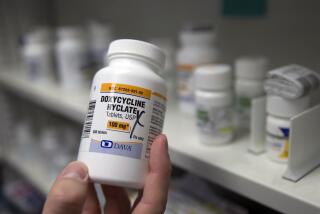Number of AIDS Diagnoses on the Rise Again in the United States
- Share via
BOSTON — For the first time since 1993, the national Centers for Disease Control and Prevention has reported an increase in the number of diagnosed AIDS cases in the United States, researchers said Tuesday.
The increase was only 1%, but scientists need to monitor it closely, said Dr. Ronald O. Valdiserri, deputy director of the CDC’s National Center for HIV, STD and TB Prevention.
“It’s only a single point in time and we can’t say it’s a trend, but it is very worrying,” Valdiserri said at the 10th Conference on Retroviruses and Opportunistic Infections.
Valdiserri also reported that the incidence of new HIV infections diagnosed among gay men climbed 14% from 1999 through 2001, significantly higher than the 8% growth among the entire U.S. population.
One way many gay men are getting together is through the Internet, which is becoming the bathhouse of the new millennium, New York researchers said.
In a survey of nearly 3,000 men, 84% said they had met sex partners online and were more likely to have unprotected intercourse than those who met partners in other ways, reported psychologist Sabina Hirshfield of the Medical and Health Research Assn. of New York City Inc. and her colleagues.
In another study, North Carolina researchers said HIV-positive inmates newly released from prison were very likely to have unprotected sex. The finding is important, said Dr. David Wohl of the University of North Carolina, because 20% of HIV-positive people in the U.S. enter or leave a correctional institution each year.
“Prisons in many ways facilitate the transmission of HIV,” Wohl said.
There are an estimated 850,000 to 950,000 people in the United States who are HIV-positive -- “more than at any point in the epidemic,” Valdiserri said. And 280,000 of them don’t know that they are infected, he added.
According to new CDC data, he said, only 5% of men and 6% of women who were newly diagnosed with the virus were tested on a health-care provider’s recommendation. An additional 5% of men and 11% of women were tested because it was offered at a clinic. The vast majority, however, were tested only when they began to become ill.
Valdiserri cautioned that the data are based on reporting in only 25 states with long-established surveillance programs and do not include high-incidence states such as California and New York.
Hirshfield and her colleagues were exploring the possibility of using the Internet as a way to promote AIDS prevention and were surprised by their findings, she said.
The men in her survey were recruited through a chat room on the popular Gay.com Web site and asked to fill out an anonymous 60-item questionnaire. Nearly 6,000 responded, but only 2,934 provided sufficient data for analysis.
One-quarter of the men reported more than 100 lifetime sex partners and 6% said they had more than 10 sex partners in the preceding month. One in 12 was HIV-positive.
Overall, 64% of the men said they had unprotected intercourse with other men they met online, compared with 58% who had unprotected sex with those they met other ways. HIV-positive men were 50% more likely to have unprotected sex than those who were HIV-negative.
Wohl and his colleagues have studied 86 HIV-positive people who were in prison for a year or two. He said their results were “somewhat surprising” in that the inmates seemed to be much less responsible than their peers who have not been in prison.
Whereas about a third of those in the general population who know they are HIV-positive say they have had unprotected sex, 78% of the inmates said they had unprotected sex in the year before their incarceration.
Upon release from custody, more than half of the inmates reported having sex within a mean of nine days.






